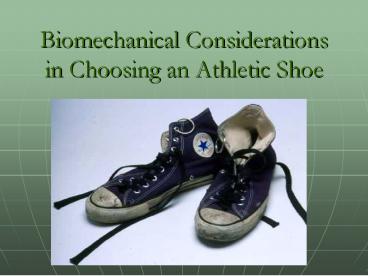Biomechanical Considerations in Choosing an Athletic Shoe - PowerPoint PPT Presentation
1 / 17
Title:
Biomechanical Considerations in Choosing an Athletic Shoe
Description:
Running Gait pattern may significantly differ from walking gait pattern, and can ... Textbook of Running Medicine, McGraw Hill ... – PowerPoint PPT presentation
Number of Views:705
Avg rating:3.0/5.0
Title: Biomechanical Considerations in Choosing an Athletic Shoe
1
Biomechanical Considerations in Choosing an
Athletic Shoe
2
(No Transcript)
3
Form Fits Function
- Evolving technology, training specialization,
sports medicine advancements and commercialism
contribute to changes in athletic shoe
construction - Different physical activities place different
biomechanical demands on the human body - Athletic shoe manufacturers are forever trying to
come up with better products, more marketable
products, and innovative products - Shoe manufacturers make many different types and
models of shoes to meet the needs of their
consumers
4
Last Construction
Last The template or model of a shoe the
general shape of the shoe is determined by the
shape of the last on which it is built
Running shoes generally have one of three last
constructions Straight, Curved, or Modified
The last can be constructed in one of several
ways Board, Slip, or Combination
5
Last Construction (cont.)
- Straight larger base with more support
materials suited for severe overpronaters - Modified hybrid shape between straight and
curved this is the most common last seen in the
construction of running shoes - Curved smaller curvilinear shaped construction
most appropriate for supinated feet lightweight
construction at the expense of stability most
common construction of track shoes
6
Anatomy of an Athletic Shoe
7
Anatomy of an Athletic Shoe- 3 Main Components
- Upper uppermost portion of the shoe typically
comprised of lightweight breathable materials
often reinforced with additional materials for
support and aesthetics - Outsole the very bottom of the shoe, composed
of various rubber materials (i.e. high carbon
rubber for durability or light weight low density
rubbers to minimize weight, or combination of the
two)
8
Anatomy of an Athletic Shoe- 3 Main Components
(cont.)
- Midsole situated between the upper and the
outsole primary role is shock absorption
manufacturers often build accessory or adjunctive
components into the midsole, i.e. pronation
controls, air or gel chambers must also be
flexible and must transfer force to forefoot
during gait this portion of the shoe has
undergone the most amount of change over the past
few decades - EVA (ethylene vinyl acetate) lightweight, soft
and flexible, can be constructed with different
densities within the same midsole - Polyurethane Foam more stable and durable
compared to EVA excellent shock absorption, but
more firm, heavier and stiffer
9
Midsole Adjunctive Components
- A pronation control device has been added to the
midsole of this Motion Control New Balance
shoe - Note the wide, relatively straight last
construction typical of pronation control shoes
and the generous midsole foam - Also note the outsole design that takes into
account a rearfoot strike and a metatarsal break
10
Midsole Adjunctive Components (cont.)
In this shoe, Nike has introduced a midsole
comprised of varying pressured air chambers
supported with structural materials to enhance
the function of the shoe
11
Categories of Running Shoes
- Neutral Cushioned Shoe designed
- for runners with a neutral to high arched
- foot who do not over pronate these shoes are
softer and - more flexible in construction, and do not have
any adjunctive - components built into the midsole to control
pronation - Stability Shoe also known as cushioned
stability shoes - often have some pronation control support may be
- incorporated into midsole designed for runners
with a - normal to slightly low arch, mild to moderate
pronators or - for heavier runners that want cushioning,
durability and control
12
Categories of Running Shoes (cont.)
- Motion Control Shoes rigid, highly supportive
and - largely inflexible shoes these shoes have
motion control - devices built into medial rearfoot midsole to
block - excessive pronation built on a wide, straight
last - designed for moderate to severe over-pronators
with flat - feet, and for heavy runners desiring more support
13
Running Shoe Examples
Saucony
Asics Brooks
motion control cushioning
stability
14
Cross Training Shoes
15
Various Specialty Shoes
Recreational Walking
Track Sprint
Tennis Shox
Nike Free
16
Analyzing the Athletes Shoe
- Gait Analysis Can be invaluable in analyzing an
athletes gait patterns, and therefore shoe need - Running Gait pattern may significantly differ
from walking gait pattern, and can be difficult
to pick up without high speed video analysis - i.e. A runner who mildly over pronates during
walking may pronate very little while running due
to decreased time in stance phase - Shoe Analysis wear of outsole can be helpful
but the material of the outsole must be
considered. Also most runners will strike with
lateral heel and will likely wear there quicker.
Midsole analysis may show greater compression
either medially or laterally, and may result in
the heel cup being deviated inwardly - Shoe recommendations must also take into account
the size and habits of the runner. One runner who
over pronates may have a greater motion control
need than another who over pronates based on size
or time spent in stance phase (running speed)
17
References
- Wilusz, P. Podiatry Today Volume 18 Issue 10
- OConnor, F and Wilder, R (2001). Textbook of
Running Medicine, McGraw Hill - Pribut, S. Separating the Buzz from the
Biomechanics Podiatric Management, Oct 2004 - Dilbert































